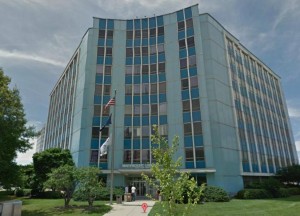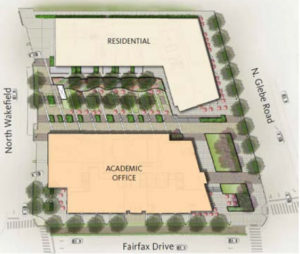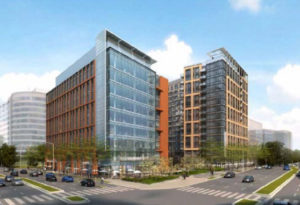 (Updated at 12:05 p.m.) A proposal for redeveloping Marymount University’s “Blue Goose” building in Ballston will go before the county’s Site Plan Review Committee tonight.
(Updated at 12:05 p.m.) A proposal for redeveloping Marymount University’s “Blue Goose” building in Ballston will go before the county’s Site Plan Review Committee tonight.
The proposal involves tearing down the existing 8-story building and replacing it with two new buildings. One would be a 9-story office and educational building, and the other would be a 15-story multi-family residence.
The L-shaped residential building would sit at the north end of the site, and would include 267 units. The ground floor would house about 3,000 square feet of retail space along Glebe Road. A landscaped plaza with specialty paving, lighting and planters would separate that building  from the office/educational building at the south end of the site, at the corner of N. Glebe Road and Fairfax Drive. The plaza plan includes outdoor seating for the retail and food vendors. A wall would separate the outdoor retail area from the ground floor residential area.
from the office/educational building at the south end of the site, at the corner of N. Glebe Road and Fairfax Drive. The plaza plan includes outdoor seating for the retail and food vendors. A wall would separate the outdoor retail area from the ground floor residential area.
Both buildings would sit on top of a 3-level underground parking structure, which would include 265 residential spaces. Currently, the Blue Goose has 202 surface parking spaces with an entrance along Glebe Road. The plan for the underground structure involves moving the parking entrance to the lesser traveled N. Wakefield Street.
 The redevelopment proposal would keep the street lane configurations the same on Glebe Road and Fairfax Drive, but expand the width of the sidewalks. The developer would also provide a cycle track adjacent to the Fairfax Drive frontage. County staff will look at how best to improve bicycle and trail access with the wider streetscape.
The redevelopment proposal would keep the street lane configurations the same on Glebe Road and Fairfax Drive, but expand the width of the sidewalks. The developer would also provide a cycle track adjacent to the Fairfax Drive frontage. County staff will look at how best to improve bicycle and trail access with the wider streetscape.
In response to comments about the historic preservation of the existing Blue Goose structure (built in 1962) — which recently made Preservation Arlington’s “Most Endangered Historic Places” list — the developer has agreed to include blue panels on the ground floor retail space’s building facade and on part of the interior.
So far, it’s unclear if this will be the last time the Site Plan Review Committee addresses the Blue Goose development, or if more tweaks to the design are anticipated at future meetings. Once the committee feels a consensus has been reached on any outstanding issues, the project will move on to the Planning Commission, and then on to the County Board for final approval.

